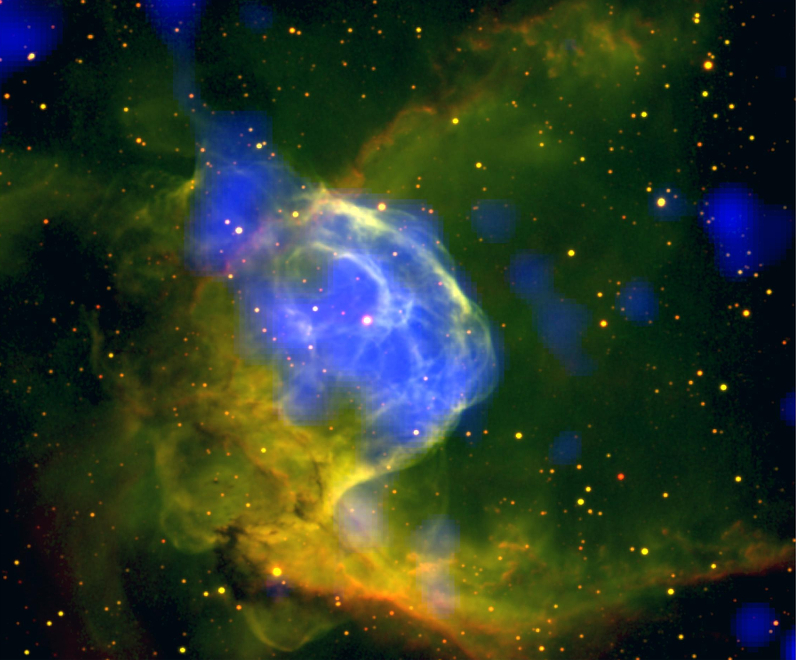
 Credit: J.A. Toala and M.A. Guerrero (IAA-CSIC), Y.-H. Chu (UIUC/ASIAA), R.A. Gruendl (UIUC), S. Mazlin, J. Harvey, D. Verschatse and R. Gilbert (SSRO-South) and ESA
Credit: J.A. Toala and M.A. Guerrero (IAA-CSIC), Y.-H. Chu (UIUC/ASIAA), R.A. Gruendl (UIUC), S. Mazlin, J. Harvey, D. Verschatse and R. Gilbert (SSRO-South) and ESA
Hot Stuff in Thor's Helmet
The evolution of very massive stars (about 20 times more massive than the sun) is largely influenced by the amounts of matter these stars lose at various stages of their lives. These stars are so bright and hot that the powerful radiation they produce drives matter off their surfaces in the form of a stellar wind that's so strong and thick that it can completely obscure the star's surface. Mass can also be lost through poorly understood, unstable, short-lived stellar eruptions. The remnants of this lost matter can be visible as a glowing nebula that surrounds the star. An example is the glowing cloud that surrounds a star named WR 7, an evolved massive star with a strong stellar wind. WR 7 is surrounded by the "Thor's Helmet" nebula, so named since it resembles the winged helmet seen in comic-book depictions of the Norse thunder god. The image above shows an optical image of the nebula from the Star Shadows Remote Observatory South at the Cerro Tololo Inter-American Observatory, with X-ray emission from the XMM-Newton X-ray observatory shown in blue. The X-ray emission is produced largely by the collision of the strong wind from WR 7 with surrounding gas and dust. This collision converts the kinetic energy of the wind (which flows at an astonishing speed of more than 3 million miles an hour) to thermal energy, raising the gas temperature up to tens of millions of degrees and making the gas glow brightly in X-rays. As seen in the image above, the hot gas mostly resides inside the boundaries marked by the cooler, optically-emitting gas, with the appearance of a blow-out of material to the upper left part of the nebula. Studies of the X-ray emitting gas help us understand how hot gas is mixed with the cooler ambient medium and how it shapes the environment within which the star will eventually explode as a core-collapse supernova or gamma-ray burst.
Published: June 8, 2015
<
HEA Dictionary ● Archive
● Search HEAPOW
● Other Languages
● HEAPOW on Facebook
● Download all Images
● Education ● HEAD
>

Each week the HEASARC
brings you new, exciting and beautiful images from X-ray and Gamma ray
astronomy. Check back each week and be sure to check out the HEAPOW archive!
Page Author: Dr. Michael F. Corcoran
Last modified Monday, 26-Feb-2024 17:47:15 EST


